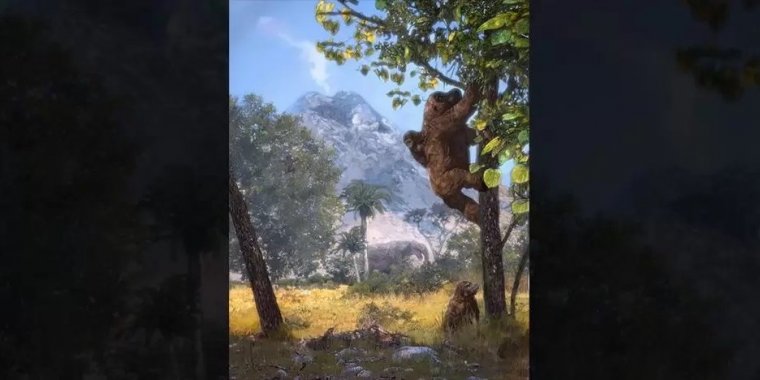| News / Science News |
Apes may have evolved upright stature for leaves, not fruit, in open woodland habitats
Anthropologists have long thought that our ape ancestors evolved an upright torso to pick fruit in forests, but new research by scientists at the University of Michigan suggests a life in open woodlands and a diet that included leaves drove apes' upright stature.

Artist's rendering of a woodland reconstruction with Morotopithecus bishopi climbing with an infant and juvenile. Photo: Corbin Rainbolt
The findings shed light on ape origins and push back the origin of grassy woodlands from between 7 million and 10 million years ago to 21 million years ago in equatorial Africa, during the Early Miocene.
Fruit grows on the spindly peripheries of trees. To reach it, large apes need to distribute their weight on branches stemming from the trunk, then reach out with their hands toward their prize.
That's much easier if an ape is upright because it can more easily grab onto different branches with its hands and feet. If its back is horizontal, then its hands and feet are generally underneath the body, making it much harder to move outward to the smaller branches — especially if the ape is large-bodied.
That's how modern-day apes reach fruit and, it's been theorized, why apes evolved to be upright, according to researchers Laura MacLatchy and John Kingston.
But new research centered around a 21-million-year-old fossil ape named Morotopithecus and led by MacLatchy suggests this might not be the case.
Instead, researchers think early apes ate leaves and lived in a seasonal woodland with a broken canopy and open, grassy areas. The researchers suggest this landscape, instead of fruit in closed canopy forests, drove apes' upright stature.
"These findings have transformed what we thought we knew about early apes, and the origin of where, when and why they navigate through trees and on the ground in different ways," said Robin Bernstein, an NSF program director for biological anthropology.
"For the first time, by combining lines of evidence, this team tied specific aspects of early apes' anatomy to environmental changes in their habitat in eastern Africa, which is more open and less forested than previously thought. The effort outlines a new framework for future studies on ape evolutionary origins." (U.S. National Science Foundation)
YOU MAY ALSO LIKE





